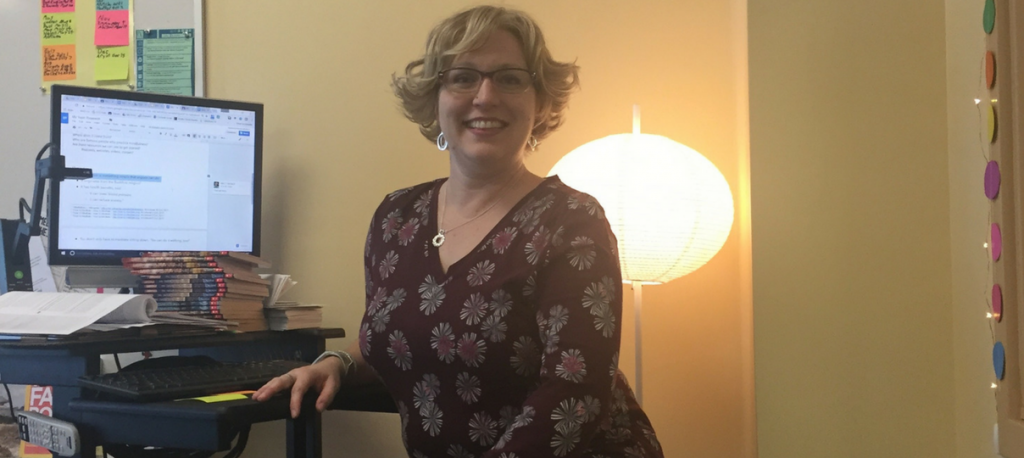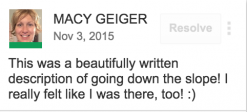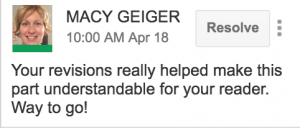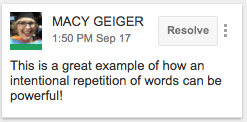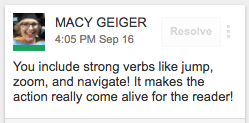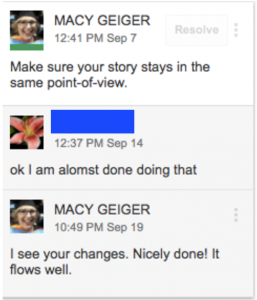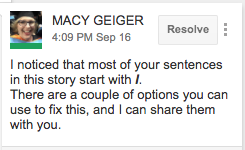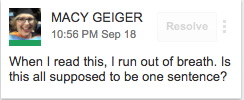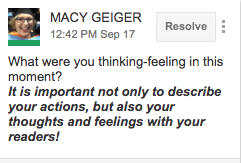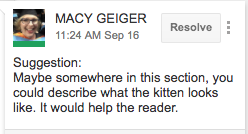This post is by member Macy Geiger.
Last year marked a new beginning at my school with the implementation of 1-to-1 Chromebooks. The integration of technology impacted my own writing curriculum and instruction as my students were suddenly typing in Google Documents rather than writing on paper. I knew I had to rethink writing instruction in the digital age, including how I assess and support writing. In Google Classroom, I could access my fourth- and fifth-grade students’ writing almost anytime, anywhere. Suddenly, I had the ability to give my writers what I couldn’t give them frequently and consistently before—my feedback. This made me wonder how I could provide effective feedback to student writers using Google Doc comments. I’ve now learned that the power of feedback lies within sharing specific strengths and focusing on a teaching point throughout the writing process; not just at the end.
Power of the Positive
Why provide positive feedback? Educator Susan M. Brookhart emphasizes the power of the words we choose and use with our students (2008). She explains that there are two main factors of feedback: a cognitive factor (the information learned) and a motivational factor (students’ feelings related to their learning). Hence, feedback is only effective when it is a clear and positive message that students understand. I reflected on my own experience as a student and realized how specific and meaningful praise would encourage me. It only makes sense that we also highlight strengths with our own students throughout the writing process.
Finding a Focused Teaching Point
When I first started teaching, there were times when my feedback seemed to highlight surface grammatical errors rather than content and organization of student writing, which did not yield any positive results. The shift to digital writing made this apparent as the spell-check tool on Google Docs handled spelling and most grammatical errors. Now I realize that my feedback should be clear and specific for the student to understand and should motivate them to improve their writing. It should focus on a teaching point that helps the student revise for quality changes, not just surface-level errors. In order to do this, I must get to know my students as writers so that I can give them appropriate advice. I do not need to expect perfection, but rather look for progress. Susan Brookhart suggests asking questions, looking for patterns, and making sure that the feedback is something the student can use.
Formative Versus Summative
In previous years, I wrestled with the lack of time and resources to provide writers with consistent feedback throughout the year. I dreaded the days when I would have to lug a bin of 20+ composition notebooks home. So I would only provide feedback in my students’ journals about once or twice a month. Now, each student has a Google Doc in our Google Classroom that I can access 24/7. At first, I would spend a lot of time giving feedback on my students’ summative piece. But they would never really get a chance to review it and apply the suggestions to their future writing. Therefore, I found it beneficial to provide more quick and formative feedback during the writing process. For example, after reviewing transitions with students in class and having them include such details in their drafts, I would ask them to highlight a section of their writing where they do this well. Then, I would visit their documents and share specific feedback on their use of transitions. That way, they had the opportunity to use my feedback to make changes to their writing.
Impact on Students
At the end of the school year, I noticed so much growth in my students’ writing. They were taking more risks and had mastered previously unknown or weaker skills, such as including sensory details and using dialogue effectively to better describe a character’s thoughts and actions. Students also shared that my feedback was valued and appreciated; they recognized how my feedback helped them. They found that the Google Comments platform was convenient and useful. When drafting in Google Docs, they began to comfortably use comments not only to reply to the teacher, but also to use as a tool for themselves or to start a conversation with me.

It was exciting to see them adapt to the comments and use them like they would use a sticky note in their composition notebooks. The Google Classroom platform enabled me to explore and solidify the best ways to communicate with my writers and help them flourish.
Technology can be powerful, but overwhelming, especially when it comes to using it mindfully in the classroom. That’s why I chose to focus on sharing my feedback via Google Comments. It was a simple successful structure to use. Yet, whether by digital or paper sticky notes, powerful feedback is positive, formative, and focused on one main teaching point. If your feedback achieves this, your students will grow!
Macy Geiger loves collaborating with her fourth- and fifth-grade learning community at PK Yonge Developmental Research School at the University of Florida. She specializes in language arts, science, and social studies instruction, and has taught writing for ten years.

